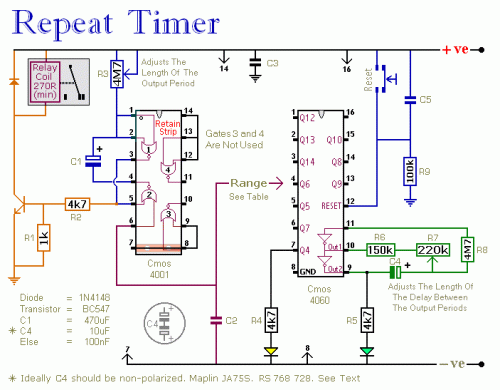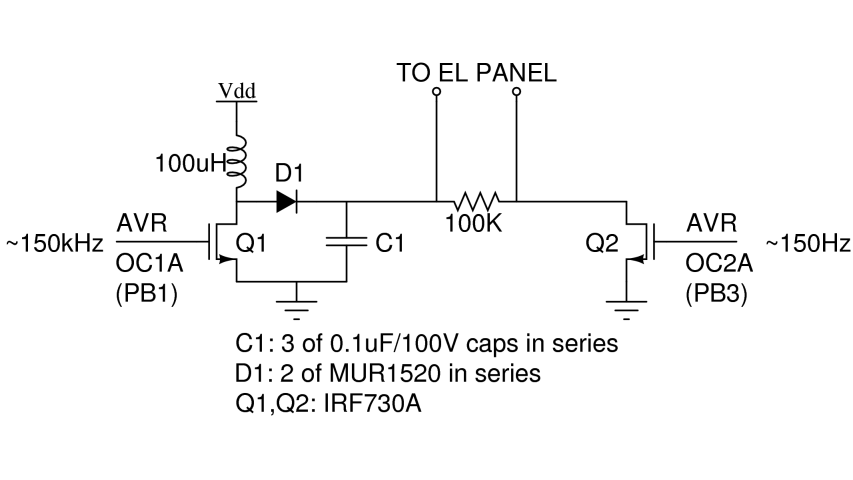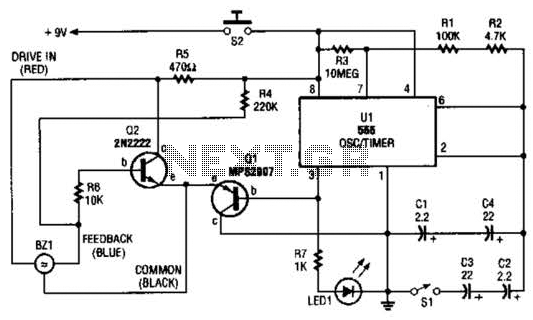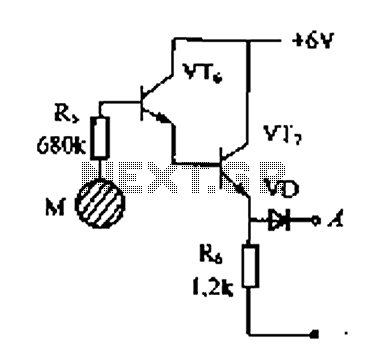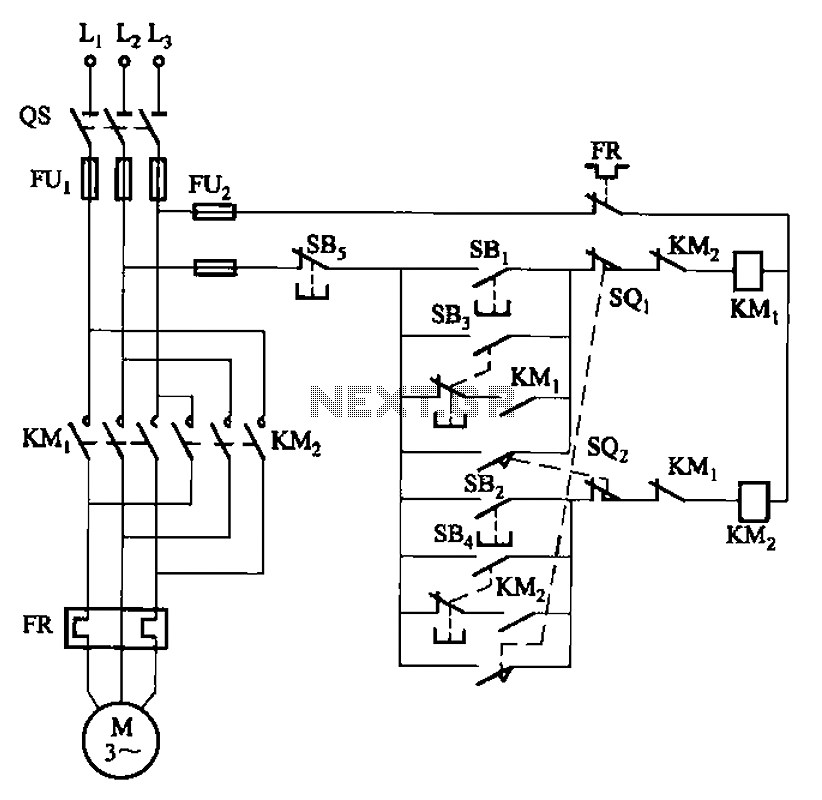
100w inverter circuit
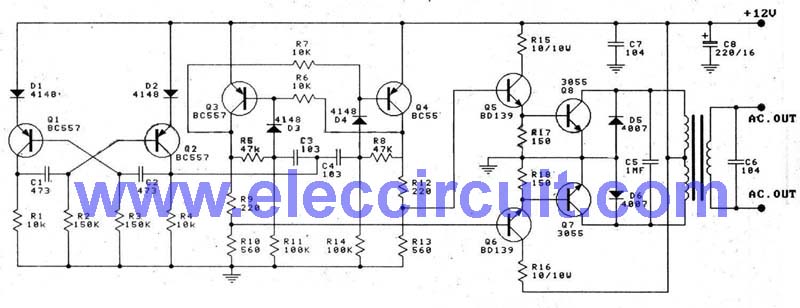
This is a 100-watt transistor inverter circuit diagram that features a straightforward design. The circuit utilizes only transistors, eliminating the need for integrated circuits. It converts a 12V battery input into a 220V output with a 50Hz square wave signal. The circuit employs two BC558 transistors and an RC network to produce a frequency of 100Hz. Additionally, two BC558 transistors further divide the frequency to achieve the desired output of 50Hz. The circuit also includes a BD139 and a 2N3055 transistor configured in a Darlington pair to drive a 12V center-tapped transformer, stepping up the voltage from 12V to 220V at 50Hz, making it fully operational for various applications. Further details can be referenced in the inverter circuit diagram.
The 100-watt transistor inverter circuit operates by utilizing a combination of bipolar junction transistors (BJTs) to achieve the desired voltage conversion and frequency output. The input from a 12V battery is connected to the base of the first pair of BC558 transistors, which are configured in a push-pull arrangement. This arrangement allows for efficient switching, generating a square wave output. The RC network plays a crucial role in determining the oscillation frequency, which is initially set at 100Hz.
To achieve the final output frequency of 50Hz, the circuit includes a second stage with another pair of BC558 transistors that function as frequency dividers. This division is essential for applications requiring a standard 50Hz output, commonly used in household electrical systems.
The Darlington pair configuration, consisting of the BD139 and 2N3055 transistors, is employed to drive the transformer effectively. The Darlington arrangement enhances the current gain, allowing the circuit to drive the transformer with sufficient power to step up the voltage from 12V to 220V. The transformer is designed as a center-tapped unit, which facilitates the conversion of the square wave signal into an alternating current (AC) output suitable for powering standard appliances.
Overall, this inverter circuit is a practical solution for converting low-voltage DC power into high-voltage AC power, making it useful for various applications, including backup power supplies and portable power systems. The simplicity of the design, utilizing discrete transistors instead of integrated circuits, contributes to its reliability and ease of construction.This is transistor inverter circuit diagram 100watt it sizes are easy circuit. Because of use the all transistor, have no the integrated circuit. It performs to modify from battery 12V be 220V 50Hz signal square wave. By the circuit works with transistor BC558 x 2pcs and RC assemble the circuit produces 100HZ frequency from that time. There is the transistor BC558 2 again, build the circuit divides by 2 times frequency be left 50Hz frequencies from that time. There is the transistor BD139 and 2N3055 each other be Darlington for drive AC transformer 12V CT 12V : 220V, enhance ac voltage 12V from be 220V 50HZ fully be usable next.
The detail is other see in inverter circuit diagram. 🔗 External reference
The 100-watt transistor inverter circuit operates by utilizing a combination of bipolar junction transistors (BJTs) to achieve the desired voltage conversion and frequency output. The input from a 12V battery is connected to the base of the first pair of BC558 transistors, which are configured in a push-pull arrangement. This arrangement allows for efficient switching, generating a square wave output. The RC network plays a crucial role in determining the oscillation frequency, which is initially set at 100Hz.
To achieve the final output frequency of 50Hz, the circuit includes a second stage with another pair of BC558 transistors that function as frequency dividers. This division is essential for applications requiring a standard 50Hz output, commonly used in household electrical systems.
The Darlington pair configuration, consisting of the BD139 and 2N3055 transistors, is employed to drive the transformer effectively. The Darlington arrangement enhances the current gain, allowing the circuit to drive the transformer with sufficient power to step up the voltage from 12V to 220V. The transformer is designed as a center-tapped unit, which facilitates the conversion of the square wave signal into an alternating current (AC) output suitable for powering standard appliances.
Overall, this inverter circuit is a practical solution for converting low-voltage DC power into high-voltage AC power, making it useful for various applications, including backup power supplies and portable power systems. The simplicity of the design, utilizing discrete transistors instead of integrated circuits, contributes to its reliability and ease of construction.This is transistor inverter circuit diagram 100watt it sizes are easy circuit. Because of use the all transistor, have no the integrated circuit. It performs to modify from battery 12V be 220V 50Hz signal square wave. By the circuit works with transistor BC558 x 2pcs and RC assemble the circuit produces 100HZ frequency from that time. There is the transistor BC558 2 again, build the circuit divides by 2 times frequency be left 50Hz frequencies from that time. There is the transistor BD139 and 2N3055 each other be Darlington for drive AC transformer 12V CT 12V : 220V, enhance ac voltage 12V from be 220V 50HZ fully be usable next.
The detail is other see in inverter circuit diagram. 🔗 External reference
